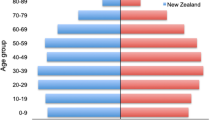Abstract
Background
The epidemiology of traumatic deaths was periodically described during the development of the American trauma system between 1977 and 1995. Recognizing the impact of aging populations and the potential changes in injury mechanisms, the purpose of this work was to provide a comprehensive, prospective, population-based study of Australian trauma-related deaths and compare the results with those of landmark studies.
Methods
All prehospitalization and in-hospital trauma deaths occurring in an inclusive trauma system at a single Level 1 trauma center [400 patients with an injury severity score (ISS) >15/year] underwent autopsy and were prospectively evaluated during 2005. High-energy (HE) and low-energy (LE) deaths were categorized based on the mechanism of the injury, time frame (prehospitalization, <48 hours, 2–7 days, >7 days), and cause [which was determined by an expert panel and included central nervous system-related (CNS), exsanguination, CNS + exsanguination, airway, multiple organ failure (MOF)]. Data are presented as a percent or the mean ± SEM.
Results
There were 175 deaths during the 12-month period. For the 103 HE fatalities (age 43 ± 2 years, ISS 49 ± 2, male 63%), the predominant mechanisms were motor vehicle related (72%), falls (4%), gunshots (8%), stabs (6%), and burns (5%). In all, 66% of the patients died during the prehospital phase, 27% died after <48 hours in hospital, 5% died after 3 to 7 days in hospital, and 2% died after >7 days. CNS (33%) and exsanguination (33%) were the most common causes of deaths, followed by CNS + exsanguination (17%) and airway compromise 8%; MOF occurred in only 3%. Six percent of the deaths were undetermined. All LE deaths (n = 72, age 83 ± 1 years, ISS 14 ± 1, male 45%) were due to low falls. All LE patients died in hospital (20% <48 hours, 32% after 3–7 days, 48% after 7 days). The causes of deaths were head injury (26%) and complications of skeletal injuries (74%).
Conclusions
The HE injury mechanisms, time frames, and causes in our study are different from those in the earlier, seminal reports. The classic trimodal death distribution is much more skewed to early death. Exsanguination became as frequent as lethal head injuries, but the incidence of fatal MOF is lower than reported earlier. LE trauma is responsible for 41% of the postinjury mortality, with distinct epidemiology. The LE group deserves more attention and further investigation.








Similar content being viewed by others
References
Baker CC, Oppenheimer L, Stephens B et al (1980) Epidemiology of trauma deaths. Am J Surg 140:144–150
Shackford SR, Mackersie RC, Holbrook TL et al (1993) The epidemiology of traumatic death: a population-based analysis. Arch Surg 128:571–575
Sauaia A, Moore FA, Moore EE et al (1995) Epidemiology of trauma deaths: a reassessment. J Trauma 38:185–193
Hossack DW (1972) The pattern of injuries received by 500 drivers and passengers killed in road accidents. Med J Aust 22:193–195
Deane SA, Gaudry Pl, Woods P et al (1998) The management of injuries: a review of deaths in hospital. Aust N Z J Surg 58:463–469
Meislin H, Criss EA, Judkins D et al (1997) Fatal trauma: the modal distribution of time to death is a function of patient demographics and regional sources. J Trauma 43:433–440
Sugrue M, Seger M, Sloane D et al (1996) Trauma outcomes: a death analysis study. Ir J Med Sci 165:99–104
Commonwealth of Australia (1994) Better health outcomes for Australians. Department of Human Services and Health, Canberra
Cothren CC, Moore EE, Hedegaard HB et al (2007) Epidemiology of urban trauma deaths: a comprehensive reassessment 10 years later. World J Surg 31:1507–1511
MacKenzie EJ, Shapiro S, Eastham JN (1995) The Abbreviated Injury Scale and Injury Severity Score: levels of inter- and intrarater reliability. Med Care 23:823–835
Ciesla DJ, Moore EE, Johnson JL et al (2005) A 12-year prospective study of post injury multiple organ failure: has anything changed? Arch Surg 140:432–440
Pang JA, Civil I, Ng A et al (2008) Is the trimodal pattern of death after trauma a dated concept in the 21st century? Injury 39:102–106
Kennedy RL, Grant PT, Blackwell D et al (2001) Low-impact falls: demands on a system of trauma management, prediction of outcome and influence of co-morbidities. J Trauma 51:717–724
Author information
Authors and Affiliations
Corresponding author
Rights and permissions
About this article
Cite this article
Evans, J.A., van Wessem, K.J.P., McDougall, D. et al. Epidemiology of Traumatic Deaths: Comprehensive Population-Based Assessment. World J Surg 34, 158–163 (2010). https://doi.org/10.1007/s00268-009-0266-1
Published:
Issue Date:
DOI: https://doi.org/10.1007/s00268-009-0266-1




